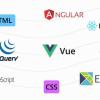Are you curious about the programming languages that data analysts use to analyze and interpret massive amounts of data? Data analysis is a crucial part of virtually every industry, from finance to healthcare, and it requires specialized knowledge in software development. This blog post will explore some of the most popular programming languages used by experts in data analysis today. Whether you're an aspiring analyst or just interested in learning more about this field, read on to discover how these top programming languages can help unlock insights from complex datasets!
Introduction to Data Analysis
Data analysis is the process of inspecting, cleansing, transforming and modeling data with the goal of discovering useful information, suggesting conclusions and supporting decision-making. Data analytics is a multi-disciplinary field that uses techniques from statistics, computer science and mathematics to glean insights from data.
There are many different programming languages that can be used for data analysis. Some of the most popular languages include R, Python, SAS and MATLAB. Each language has its own strengths and weaknesses, so it's important to choose the right language for the task at hand. In this blog post, we'll explore the top programming languages used in data analysis and provide a brief introduction to each one.
Python for Data Analysis: Advantages and Disadvantages
Python is a versatile language that has many advantages and disadvantages when it comes to data analysis. On the plus side, Python is relatively easy to learn, even for those with no prior programming experience. Additionally, Python has a large number of libraries and tools available specifically for data analysis tasks, which can save time and effort compared to other languages. Finally, Python code is typically more compact and readable than code written in other languages, making it easier to debug and maintain.
On the downside, Python can be slower than some alternatives (such as C++), particularly when working with large amounts of data. Additionally, because Python is an interpreted language, errors can be harder to track down than in compiled languages. Finally, some users find Python's syntax less intuitive than that of other languages.
R Programming Language for Data Analysis: Pros and Cons
The R programming language is a popular choice for data analysis. It has many features that make it well suited for this task, but there are also some drawbacks to using R.
One of the main advantages of R is that it is free and open source. This means that anyone can use it and contribute to its development. There are also a wide variety of packages available for R, which makes it easy to extend its functionality.
Another advantage of R is that it is a very versatile language. It can be used for both statistical analysis and data visualization. Additionally, R integrates well with other software, such as Excel and Python.
However, there are some drawbacks to using R. One of the biggest complaints about R is its steep learning curve. It can be difficult for beginners to get started with R, and even experienced users can find it challenging to use all of its features effectively. Additionally, R can be slow when working with large datasets. And finally, because R is open source, there is no single company or organization responsible for maintaining and supporting it.
SQL in Data Analysis: Advantages and Disadvantages
SQL is a powerful tool for data analysis, offering many advantages over other languages. However, there are also some disadvantages to using SQL that should be considered before deciding whether or not to use it for your project.
Advantages:
1. SQL is very versatile and can be used for a variety of tasks, from retrieving data to performing complex calculations.
2. SQL is easy to learn and use, even for beginners.
3. SQL is very efficient and can handle large amounts of data quickly and easily.
4. SQL can be used on a variety of platforms, including Windows, Linux, and MacOS.
5. SQL databases are widely used and well-supported, making it easy to find help and resources when needed.
6. With SQL, it is easy to update or change data as needed without having to edit the entire dataset manually.
7. SQL offers a high level of security, protecting your data from unauthorized access or modification.
8.SQL queries can be easily saved and reused later on, making it easy to perform the same analysis on different datasets or at different times.
9 . The results of SQL queries can be exported into various formats (e CSV files) for further analysis or for use in other applications
SAS Programming Language for Data Science: Benefits and Downsides
SAS is a powerful statistical analysis software that is used by many data scientists. However, SAS has some drawbacks that should be considered before using it for data analysis.
Benefits:
1. SAS is easy to use and has a wide range of statistical procedures that can be used for data analysis.
2. SAS can handle large datasets and can be used for both exploratory data analysis and confirmatory data analysis.
3. SAS provides a variety of graphical tools for data visualization, which can be helpful in understanding the data.
4. SAS is widely used in the industry and is known for its stability and reliability.
Downsides:
1. SAS is a commercial software and can be expensive to purchase and maintain.
2. SAS code can be difficult to read and understand, making it difficult to share with others or collaborate on projects.
3. Some newer statistical software packages ( such as R ) are free and open source, while SAS is proprietary software. This can make it harder to find help or support when using SAS.
Julia Programming Language for Data Science: Pros and Cons
There are a variety of programming languages that data scientists can use to perform their work, and each has its own set of pros and cons. In this article, we'll take a closer look at the Julia programming language and explore some of its key advantages and disadvantages for data science applications.
One of the biggest advantages of Julia is its speed. Compared to other popular languages like R and Python, Julia is much faster when it comes to executing code. This can be a major advantage when working with large datasets or complex algorithms.
Another plus for Julia is its syntax. Julia's syntax is designed to be easy to read and understand, which can make code development quicker and simpler. This can be a big advantage for novice programmers who are just getting started in data science.
However, there are also some potential drawbacks to using Julia for data science. One challenge is that it can be difficult to find good quality libraries and tools for data analysis tasks. Additionally, because Julia is a relatively new language, there is still a relatively small community of users compared to other languages like R and Python. This can make finding help and resources more difficult.
Conclusion
As the data analysis field continues to evolve, different programming languages are being used for various applications. Python and R are two of the most popular programming languages for data analysis due to their flexibility and powerful capabilities. Other languages such as Java, C#, and JavaScript have their own unique uses in this area as well. Ultimately, it is important to explore each language before deciding which one suits your particular needs best. With the right knowledge and dedication, you can become an expert in any of these top programming languages used in data analysis.




